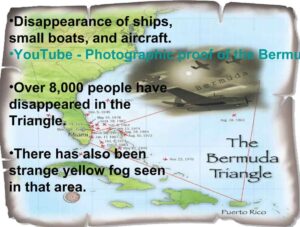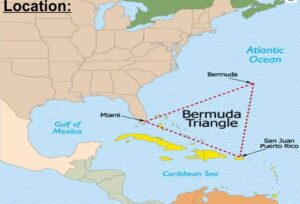The Bermuda Triangle, also known as the “Devil’s Triangle,” is a loosely defined region in the western part of the North Atlantic Ocean. This area has gained notoriety due to the alleged mysterious disappearances of ships and aircraft, fueling various theories and capturing the public’s imagination. While the concept of the Bermuda Triangle has been popularized in books, documentaries, and movies, its history is less a tale of supernatural phenomena and more a mix of human error, natural factors, and sensationalism.
The origin of the Bermuda Triangle legend can be traced back to the mid-20th century. The term was coined by writer Vincent Gaddis in a magazine article published in 1964 and later popularized in his book “Invisible Horizons: True Mysteries of the Sea” (1965). Gaddis, along with other authors and journalists, began compiling and sensationalizing stories of mysterious disappearances, creating an aura of intrigue and fear around the region.
One of the earliest incidents attributed to the Bermuda Triangle occurred in 1945 when Flight 19, a squadron of five U.S. Navy bombers, disappeared during a training flight. The aircraft was never found, and the lack of a conclusive explanation fueled speculation about paranormal or extraterrestrial involvement. However, subsequent investigations suggested that navigational errors, fuel exhaustion, and miscommunication likely contributed to the disappearance.

Over the years, several other incidents have been linked to the Bermuda Triangle, including the disappearance of the USS Cyclops in 1918 and the Flight 441 disappearance in 1958. Despite the mystery surrounding these events, many of the purported disappearances have been debunked or explained by conventional factors such as human error, extreme weather conditions, and mechanical failures.
The United States Board on Geographic Names does not recognize the Bermuda Triangle as an official name, and the U.S. government does not consider it a real hazard to air or sea traffic. In fact, the area experiences a similar rate of incidents as other heavily traveled regions worldwide.
Scientists and experts emphasize that the Bermuda Triangle myth is largely a product of selective reporting, sensationalism, and the tendency to ignore mundane explanations in favor of more mysterious ones. The region’s notoriety persists in popular culture, but its alleged supernatural aura has been largely debunked by those who approach the topic with a critical and scientific mindset.
Location of Bermuda Triangle
The Bermuda Triangle, also known as the Devil’s Triangle, is a loosely defined region in the western part of the North Atlantic Ocean. Its vertices are generally considered to be Miami (Florida, USA), Bermuda, and San Juan (Puerto Rico). This triangular area encompasses approximately 500,000 square miles (1.3 million square kilometers) of the Atlantic Ocean.

The northern point of the triangle is marked by Bermuda, a British Overseas Territory situated in the North Atlantic. To the south, the triangle extends to Miami, Florida, a major city on the southeastern coast of the United States. The eastern point is often considered to be San Juan, the capital city of Puerto Rico.
While the boundaries of the Bermuda Triangle are not officially recognized, the region is known for its historical association with mysterious disappearances of ships and aircraft. Despite its enigmatic reputation, the Bermuda Triangle is a heavily traveled area, and the vast majority of vessels and aircraft navigate through it without incident.
Explore More
Selective Reporting: Many accounts of incidents in the Bermuda Triangle have been subject to selective reporting, where only mysterious disappearances are highlighted, while successful journeys through the area are often overlooked. This skewed reporting contributes to the myth by creating a false impression of a higher incidence of unexplained disappearances.
Human Error: A significant number of incidents within the Bermuda Triangle can be attributed to human error, including navigation mistakes, misinterpretation of instruments, and poor decision-making. Pilots and sailors may encounter challenges in the complex and often unpredictable environment of the region, leading to accidents that are unfortunately labeled as mysterious disappearances.
Communication Challenges: In the past, limited communication technology might have contributed to delays in reporting incidents or receiving assistance. This could have led to a perception of sudden disappearances when, in reality, the time lapse between an incident and its documentation or notification was due to technological constraints.
Improvements in Technology: Advances in navigation technology and communication systems have significantly enhanced the safety of maritime and aviation travel in the Bermuda Triangle and other regions. Modern vessels and aircraft are equipped with sophisticated instruments that provide accurate navigation, reducing the likelihood of accidents attributed to navigational errors.
Misattribution of Incidents: Some incidents attributed to the Bermuda Triangle have been found to occur outside the defined boundaries of the region. This misattribution further questions the validity of the myth, as incidents that are included in the narrative might not have occurred within the triangle itself.
Lack of Scientific Consensus: The scientific community widely dismisses the idea of a Bermuda Triangle anomaly. Organizations such as the U.S. Board on Geographic Names and the U.S. government do not officially recognize the Bermuda Triangle as a hazardous area. The lack of scientific consensus reinforces the notion that the myth is more rooted in sensationalism than genuine scientific inquiry.
Popular Culture Influence: The Bermuda Triangle has become ingrained in popular culture through books, documentaries, and movies that emphasize its mysterious nature. While these portrayals entertain audiences, they also perpetuate the myth by amplifying the perceived supernatural aspects of the region.
Natural Disasters: The Atlantic Ocean is susceptible to natural disasters such as hurricanes and powerful storms. These events can pose significant risks to maritime and aviation travel, and incidents occurring during such weather conditions are often attributed to the Bermuda Triangle myth rather than recognized as the result of natural phenomena.
Tourism and Commercial Interests: The allure of the Bermuda Triangle has led to an influx of tourism and commercial interests in the region. Businesses capitalize on the mystery, offering tours and experiences centered around the myth, further perpetuating its cultural significance.
Legacy of the Myth: Despite efforts to debunk the Bermuda Triangle myth, its legacy endures, captivating the public’s imagination and ensuring its place in the realm of speculative phenomena. The myth serves as a reminder of the human inclination toward mystery and the enduring power of folklore in shaping our perception of the unknown.
Scientific Studies and Explanations: Numerous scientific studies have debunked the paranormal theories associated with the Bermuda Triangle. Researchers and scientists have provided logical explanations for many incidents, emphasizing factors such as oceanic methane hydrate eruptions, underwater landslides, and rogue waves. These phenomena, while natural, can have significant impacts on vessels.
Search and Rescue Operations: The international community conducts extensive search and rescue operations in the Bermuda Triangle, employing advanced technologies and coordinated efforts. These operations aim to swiftly respond to distress calls or incidents, highlighting the commitment to ensuring the safety of maritime and aviation activities in the region.
Insurance Industry Perspective: The insurance industry, which meticulously assesses risks associated with maritime and aviation routes, does not consider the Bermuda Triangle as a higher-risk area. Insurance premiums for vessels and aircraft passing through this region are not significantly different from those in other parts of the world, underscoring the lack of perceived danger by industry experts.
Statistical Analysis: When incidents in the Bermuda Triangle are subjected to statistical analysis, the region does not exhibit an abnormal or alarming rate of disappearances compared to other heavily traveled areas. This statistical perspective further challenges the notion that the Bermuda Triangle poses a unique and unexplained risk to navigation.
Educational Outreach: Efforts to dispel the Bermuda Triangle myth include educational outreach programs aimed at promoting awareness of the scientific explanations behind reported incidents. By disseminating accurate information, these programs seek to counteract the sensationalized narratives that contribute to the perpetuation of the myth.
Global Perspectives on Mystery Regions: Similar mysterious regions exist in other parts of the world, such as the Devil’s Sea in the Pacific Ocean. These areas share stories of unexplained disappearances, fostering a global fascination with the unknown. Examining these regions collectively underscores the human tendency to ascribe mystery to specific geographical locations.
Historical Context of Myths: The Bermuda Triangle myth is not an isolated phenomenon but part of a broader history of myths and legends associated with the sea. Throughout human history, maritime environments have been fertile ground for the creation of tales featuring supernatural elements, reflecting a cultural fascination with the vast and unpredictable nature of the oceans.
Cultural Impact: The Bermuda Triangle has permeated various aspects of culture, from literature and art to music and film. Its influence extends beyond the realm of scientific inquiry, shaping perceptions and contributing to a broader cultural fascination with the mysterious and unexplored corners of the Earth.
Ongoing Research: Despite the wealth of information and debunking efforts, ongoing research continues to explore the environmental factors and historical incidents associated with the Bermuda Triangle. This research is conducted not to validate paranormal claims but to deepen our understanding of the complex interactions between natural elements and human activities in the region.
Legacy of Exploration: The Bermuda Triangle has, in a paradoxical manner, become a symbol of exploration and curiosity. While the myth itself is debunked, the region continues to attract researchers, explorers, and scientists interested in unraveling the geological, oceanographic, and atmospheric intricacies that define this area of the North Atlantic Ocean.
Bermuda Triangle has a storied history of mysterious disappearances, a closer examination reveals that many incidents can be explained by ordinary factors. The legend of the Bermuda Triangle continues to be a captivating aspect of maritime and aviation folklore, blending fact and fiction in the vast expanse of the Atlantic Ocean.
Conclusion
Bermuda Triangle, with its mystique and tales of unexplained disappearances, has left an indelible mark on popular culture. While its reputation as a paranormal hotbed has been debunked through scientific scrutiny and rational inquiry, the region remains a symbol of humanity’s enduring fascination with the unknown. The history of the Bermuda Triangle is a tale of navigational challenges, human error, and the power of storytelling to transform a geographical area into a realm of mystery and intrigue.
As we reflect on the journey through the Bermuda Triangle’s history, it becomes clear that separating fact from fiction is essential in understanding our world. The legacy of exploration in this region stands as a testament to our innate curiosity and the ongoing quest for knowledge. In navigating the waters of historical understanding, the Bermuda Triangle serves not only as a cautionary tale about the creation of myths but also as a reminder of the importance of critical thinking and scientific inquiry in unraveling the mysteries that captivate our collective imagination.
A big thank you for exploring Techlesnar.com! Your visit means a lot to us, and we’re grateful for your time on our platform. If you have any feedback or suggestions, we’d love to hear them. Looking forward to serving you again soon!

